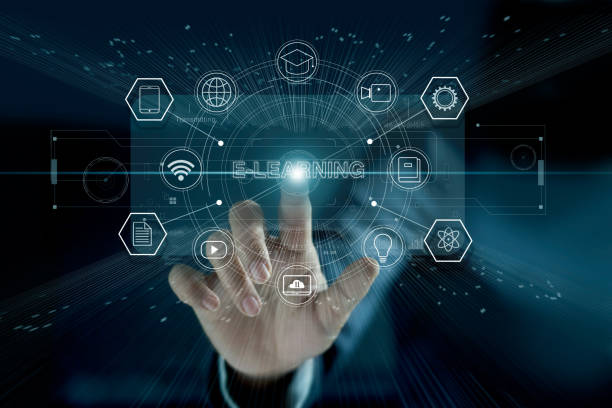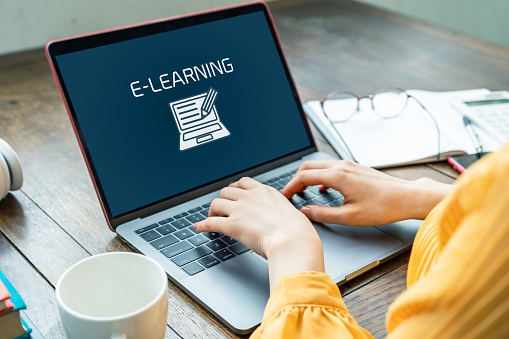Meaning of digital learning (E-learning)
- E-learning- The term e-learning was first used in a seminar in Los Angeles in the year 1999, when the expansion of the internet was also very low and the number of internet users was also very low, due to which e-learning was more popular at that time. There is a lot of difference between e-learning in that era and this era. Then only 5% of the people knew about the Internet. People neither knew the meaning of the internet nor knew how to use the internet. But in today’s era, 99% of the people know about the Internet. Nowadays more work has also gone through the Internet. Everyone has become dependent on the internet. In the same way, e-learning is also a part of the Internet through which education is obtained. E-learning is also called Electronic learning or digital learning.

- The meaning of digital learning is to provide education or to receive education to the students sitting at home through any technical assistance and the internet. Our era today has become a completely modern era. Where every task can be done quickly and easily with the help of a computer and the Internet. Everything in all types of business fields has become modern technological and digital. After an epidemic like coronavirus, more importance has been given to digital work and digital education. Similarly, in the field of education, work has been done digitally. The mainstay of digital education is the Internet. With the help of this education can be obtained.
- This digital learning or E-learning is mainly done by connecting devices like computers, mobiles, laptops, tablets, etc. through the Internet. Students do not need to go to school for this education. Through this education, students can get an education even sitting at home, and in the same way, teachers do not need to go to school. Teachers can also impart knowledge to children through digital education. In digital education, a teacher can also teach all his students at the same time.

- Through digital learning, children can connect with teachers sitting at home through the internet.
The importance of digital education has increased a lot in the present time. Because students are getting many benefits from this. Students have started getting education sitting at home. His time to come to school has also started saving. The trend of digital education has increased after the coronavirus epidemic. Through this type of education, children have been saved from this epidemic. Being long a short distance does not have any impact on digital learning.
Types of Digital Learning (E-Learning)
1. Synchronous Digital Learning– Synchronous learning is a real-time learning method. Teachers and students through the Internet are connected in a meeting and they have two-way communication means teachers and students can talk to each other in Synchronous e-learning. There is a virtual classroom-like environment in which many children are connected online, so the doubts about any subject are easily cleared here because here you can immediately ask your questions to the teacher. In synchronous digital learning, a real classroom environment is created.
Synchronous E-learning is connected through these mediums-
1. Audio conferencing- Audioconferencing may refer to a learning meeting in which participants in different locations use the telephone to communicate with each other at the same time or an audio conferencing function through a mobile phone. The number of participants can be as few as 3 or as many as 100 or more.
2. Video conferencing- Video conferencing is a type of online meeting where multiple people can join a live audio-visual call. Video conferencing requires a strong internet connection. All participants can see, hear, and talk to each other in real time, wherever they are in the world. It is easy for them to see each other and talk.
3. Virtual classrooms – This computer laptop is on mobile, it looks like a real class. They have the advantage that any person can record them and watch them anywhere and anytime and solve their problems. If you do not understand something, you can also see it in reverse.
4. Webinar- Webinar simply means having seminars through the internet, that we can attend online. Webinar means Web + Seminar = Webinar. Seminars are those which have to be held in real and have to be attended. Whose time is also given, as well as where it is going to be, is also known. But during the time of lockdown, the seminar has been replaced by a webinar. Because we can’t go out because of Corona. We can attend the same seminars from anywhere in the comfort of our homes. So they are webinars. It is not that webinars were not there earlier, they used to give less preference to webinars and more to seminars. But it has become more popular during the time of webinar lockdown.
5. Chat- The meaning of chat is to exchange ideas with mobiles, tablets, and computer users from home and abroad connected to the Internet. Many servers provide a chat facility.
2. Asynchronous Digital Learning- Asynchronous digital learning is not a real-time e-learning method, which means there is no interaction between student and teacher, that means students and instructors are not interconnected through any online medium, so in Asynchronous digital or E-learning method the learner has to do self study on his own. Examples of Asynchronous Digital Learning are Online Courses, Blogs/Websites, and Videos Tutorials.
Advantages of E-learning or digital learning-
1. The biggest advantage of e-learning or digital learning is that you can study from any location according to your time. If anyone has any problem in studying or going to the classroom, then they can study from home through digital learning.
2. The cost of studying online is much less because here you save the cost of books, notebooks, pens, and other educational materials. If you miss a class in your classroom, you cannot read it again, but if you miss a class in e-learning, you can watch it again later because the class can be recorded in e-learning.
3. In digital learning any concept is easily understood because, in the online class, it is not taught only on the blackboard, here it is easy to understand any concept with things like educational films, and graphical presentations.
Disadvantages of E-learning or digital learning-
1. The biggest disadvantage of e-learning or digital learning is to those students who are not serious about their studies because online learning has to be self-dependent and self-study.
2. In e-learning the interaction of teacher and students is not so special as it happens in the classroom. It is difficult to learn practical things in online education.

